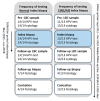High-Grade Cervical Intraepithelial Neoplasia (CIN) Associates with Increased Proliferation and Attenuated Immune Signaling
- PMID: 35008799
- PMCID: PMC8745058
- DOI: 10.3390/ijms23010373
High-Grade Cervical Intraepithelial Neoplasia (CIN) Associates with Increased Proliferation and Attenuated Immune Signaling
Abstract
Implementation of high-risk human papilloma virus (HPV) screening and the increasing proportion of HPV vaccinated women in the screening program will reduce the percentage of HPV positive women with oncogenic potential. In search of more specific markers to identify women with high risk of cancer development, we used RNA sequencing to compare the transcriptomic immune-profile of 13 lesions with cervical intraepithelial neoplasia grade 3 (CIN3) or adenocarcinoma in situ (AIS) and 14 normal biopsies from women with detected HPV infections. In CIN3/AIS lesions as compared to normal tissue, 27 differential expressed genes were identified. Transcriptomic analysis revealed significantly higher expression of a number of genes related to proliferation, (CDKN2A, MELK, CDK1, MKI67, CCNB2, BUB1, FOXM1, CDKN3), but significantly lower expression of genes related to a favorable immune response (NCAM1, ARG1, CD160, IL18, CX3CL1). Compared to the RNA sequencing results, good correlation was achieved with relative quantitative PCR analysis for NCAM1 and CDKN2A. Quantification of NCAM1 positive cells with immunohistochemistry showed epithelial reduction of NCAM1 in CIN3/AIS lesions. In conclusion, NCAM1 and CDKN2A are two promising candidates to distinguish whether women are at high risk of developing cervical cancer and in need of frequent follow-up.
Keywords: CIN progression; cervical cancer screening; differential gene expression; transcriptomic analysis.
Conflict of interest statement
The authors declare no conflict of interest. The funder had no role in the design of the study; in the collection, analyses, or interpretation of data; in the writing of the manuscript, or in the decision to publish the results.
Figures




Similar articles
-
Gene expression levels associated with impaired immune response and increased proliferation could serve as biomarkers for women following cervical cancer screening programmes.Front Immunol. 2024 Dec 6;15:1507193. doi: 10.3389/fimmu.2024.1507193. eCollection 2024. Front Immunol. 2024. PMID: 39712018 Free PMC article.
-
Accumulation of invariant NKT cells with increased IFN-γ production in persistent high-risk HPV-infected high-grade cervical intraepithelial neoplasia.Diagn Pathol. 2015 Apr 2;10:20. doi: 10.1186/s13000-015-0254-8. Diagn Pathol. 2015. PMID: 25885042 Free PMC article.
-
Overall efficacy of HPV-16/18 AS04-adjuvanted vaccine against grade 3 or greater cervical intraepithelial neoplasia: 4-year end-of-study analysis of the randomised, double-blind PATRICIA trial.Lancet Oncol. 2012 Jan;13(1):89-99. doi: 10.1016/S1470-2045(11)70286-8. Epub 2011 Nov 8. Lancet Oncol. 2012. PMID: 22075171 Clinical Trial.
-
Human Papillomavirus Genotype Distribution among Thai Women with High-Grade Cervical Intraepithelial Lesions and Invasive Cervical Cancer: a Literature Review.Asian Pac J Cancer Prev. 2015;16(13):5153-8. doi: 10.7314/apjcp.2015.16.13.5153. Asian Pac J Cancer Prev. 2015. PMID: 26225645 Review.
-
Epidemiology of cervical intraepithelial neoplasia: the role of human papillomavirus.Baillieres Clin Obstet Gynaecol. 1995 Mar;9(1):1-37. doi: 10.1016/s0950-3552(05)80357-8. Baillieres Clin Obstet Gynaecol. 1995. PMID: 7600720 Review.
Cited by
-
Diagnosis of Cervical Intraepithelial Neoplasia and Invasive Cervical Carcinoma by Cervical Biopsy under Colposcopy and Analysis of Factors Influencing.Emerg Med Int. 2022 Jul 30;2022:9621893. doi: 10.1155/2022/9621893. eCollection 2022. Emerg Med Int. 2022. Retraction in: Emerg Med Int. 2024 Jan 24;2024:9798474. doi: 10.1155/2024/9798474. PMID: 35941961 Free PMC article. Retracted.
-
Sequencing-based transcriptome analysis reveals diversification of immune response- and angiogenesis-related expression patterns of early-stage cervical carcinoma as compared with high-grade CIN.Front Immunol. 2023 Sep 4;14:1215607. doi: 10.3389/fimmu.2023.1215607. eCollection 2023. Front Immunol. 2023. PMID: 37731500 Free PMC article.
-
An Integrated Bioinformatics Analysis towards the Identification of Diagnostic, Prognostic, and Predictive Key Biomarkers for Urinary Bladder Cancer.Cancers (Basel). 2022 Jul 10;14(14):3358. doi: 10.3390/cancers14143358. Cancers (Basel). 2022. PMID: 35884419 Free PMC article.
-
Early-Stage and Locally Advanced Cervical Cancer during Pregnancy: Clinical Presentation, Diagnosis and Treatment.Medicina (Kaunas). 2024 Oct 16;60(10):1700. doi: 10.3390/medicina60101700. Medicina (Kaunas). 2024. PMID: 39459487 Free PMC article. Review.
-
Transcriptomic profile of the immune genes, oncogenes, and tumor suppressor genes in HPV associated Cervical Intraepithelial Neoplasia 3 (CIN 3) and Cervical Squamous Cell Carcinoma (CSCC): Comparable expressions indicative of invasive potential.Tumour Virus Res. 2025 Aug 5;20:200327. doi: 10.1016/j.tvr.2025.200327. Online ahead of print. Tumour Virus Res. 2025. PMID: 40752830 Free PMC article.
References
-
- McCredie M.R., Sharples K.J., Paul C., Baranyai J., Medley G., Jones R.W., Skegg D.C. Natural history of cervical neoplasia and risk of invasive cancer in women with cervical intraepithelial neoplasia 3: A retrospective cohort study. Lancet Oncol. 2008;9:425–434. doi: 10.1016/S1470-2045(08)70103-7. - DOI - PubMed
MeSH terms
Substances
Grants and funding
LinkOut - more resources
Full Text Sources
Medical
Research Materials
Miscellaneous

